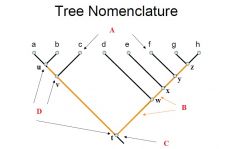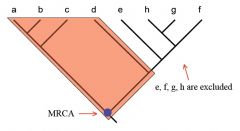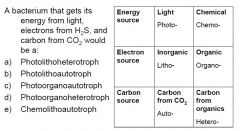![]()
![]()
![]()
Use LEFT and RIGHT arrow keys to navigate between flashcards;
Use UP and DOWN arrow keys to flip the card;
H to show hint;
A reads text to speech;
119 Cards in this Set
- Front
- Back
|
**What is the Tree of Life?
|
Concept
-all living organisms are related to one another through SHARED ANCESTRY Phylogeny shown as a tree--a simplified model of the genealogy of life Shows diversity, relationships, similarities, & differences |
|
|
**What is Phylogeny?
|
Evolutionary History
|
|
|
*Classification: Polynomial System
|
Pre-1700's
Organisms grouped into diff. kinds (genus/genera) EX: Catnip Nepeta floribus interrupte spicatus pedunculatus |
|
|
*Classification: Binomial System
|
Linneaus (1753)
Genus + Specific Epithet EX: Catnip Nepeta cataria |
|
|
*(T/F)
Taxonomy is hierarchical |
True
|
|
|
*What is the hierarchy of taxonomy from broad to specific?
|
Domains
Kingdom Phylum Class Order Families Genus+Species |
|
|
*When naming species, especially if its more inclusive (eg genera, families), try to ensure they are ____ groups
|
monophyletic
(MRCA in a single clade contains all descendents) |
|
|
*(T/F)
The Tree of Life is time independent |
False
Time Dependent |
|
|
*(T/F)
The tree of life is a 4 billion year history of evolution |
True
|
|
|
*(T/F)
Phylogenetic trees are complex models of a much more simple set of biological processes |
False
Phylogenetic trees are SIMPLE models |
|
|
**What is Speciation?
|
Process
-1 species -> 2 descendent species On Tree: -branching (splitting) point |
|
|
*(T/F)
Phylogenies are the result of multiple speciation & extinction events over long periods of time |
True
|
|
|
*(T/F)
Terminal nodes on a tree represent hypothetical ancestral taxa |
False
Internal nodes |
|
|
What is Biology?
|
scientific study of living organisms, including their characteristics, functions, and interactions
|
|
|
What are Cells?
|
basic structural and physiological units of life
|
|
|
What is the Cell Theory?
|
all life consists of cells and that all cells come from preexisting cells
|
|
|
(T/F)
Evolution by natural selection is responsible for the diversity of adaptations found in living organisms. |
True
|
|
|
The instructions for a cell are contained in its ___
|
genome (made of DNA, which is made of nucleotides)
|
|
|
What are Genes?
|
Specific segments of DNA
contain the information the cell uses to make proteins |
|
|
(T/F)
Living organisms regulate their internal environment. They also interact with other organisms of the same and different species. Biologists study life at all these levels of organization |
True
|
|
|
(T/F)
Biological knowledge obtained from a model system may be generalized to other species |
True
|
|
|
(T/F)
Biologists use fossils, anatomical similarities and differences, and molecular comparisons of genomes to reconstruct the history of life. |
True
|
|
|
Life first arose by ____ evolution
|
chemical
|
|
|
___ arose early in the evolution of life
|
Cells
|
|
|
Why is Photosynthesis is an important evolutionary step?
|
it changed Earth’s atmosphere and provided a means of capturing energy from sunlight
|
|
|
(T/F)
The earliest organisms were prokaryotes. Organisms called eukaryotes, with more complex cells, arose later. Eukaryotic cells have discrete intracellular compartments, called organelles, including a nucleus that contains the cell’s genetic material. |
True
|
|
|
**Species are grouped into 3 domains:
|
Archaea, Bacteria, Eukarya
|
|
|
**(T/F)
Archaea and Bacteria are domains of unicellular prokaryotes. |
True
|
|
|
Biological species concept distinguishes species on the basis of...
|
reproductive isolation
|
|
|
Morphological species concept distinguishes species on the basis of...
|
physical similarities
it often underestimates or overestimates the actual number of reproductively isolated species |
|
|
Lineage species concept distinguishes species on the basis of...
|
branch on the tree of life
|
|
|
Speciation usually results from...
|
interruption of gene flow within a population
|
|
|
What is Allopatric Speciation?
|
populations are separated by a physical barrier
result from founder events |
|
|
What is Sympatric Speciation?
|
genomes of two groups diverge in the absence of physical isolation
result of disruptive selection (Selection in which phenotypes at both extremes of the population distribution are favored) occur within two generations via polyploidy, an increase in the number of chromosomes sets |
|
|
(T/F)
Polyploidy may arise from chromosome duplications within a species (autopolyploidy) or from hybridization that results in combining the chromosomes of two species (allopolyploidy) |
True
|
|

*A
|
Terminal (Tip) Taxa
|
|

*B
|
Internal Branches
|
|

*C
|
Root, Root Node
|
|

*D
|
Internal Nodes
|
|

*
(T/F) "Order" left-to-right has no meaning on a tree |
True
You can "rotate" tree branches around nodes and not change the meaning of the tree |
|
|
*
What are Bifurcating Trees? |
Internal node gives 2 descendents
|
|
|
***
What are Polytomies? |
Nodes give 3+ descendents
Reflects UNCERTAINTY about phylogenetic relationships |
|
|
*
What is a Monophyletic Group? |
group of organisms consisting of MRCA and ALL its descendents
|
|
|
*
What is a Clade? |
a monophyletic group
|
|
|
*
What is a Paraphyletic Group? |

group of organisms consisting of MCRA but EXCLUDES some descendents
|
|
|
*
What is a Polyphyletic Group? |

group of organisms that EXCLUDES MRCA
|
|
|
**
What is the relationship between the number of monophyletic groups and the number of internal nodes in a tree? |
# Internal nodes = # Clades
Excludes Terminal Taxa |
|
|
*
What are Non-Monophyletic Groups |
Groups that include some but not all descendents of MRCA
Polyphyletic Groups Paraphyletic Groups |
|
|
**
What are Synapomorphies? |
Monophyletic groups or clades
UNIQUE characters inherited from common ancestor to that group ONLY |
|
|
*
(T/F) Synapomorphies are always homologous. |
True
|
|
|
*
(T/F) Homologous traits are always synapomorphies |
False
|
|
|
**
What are Homologous Traits? |
Inherited from a common ancestor
|
|
|
*
What is Convergence? |
Evolved INDEPENDENTLY
unrelated species subjected to similar environments |
|
|
*
What are Sister Groups? |
2 clades or species that are each other's closest relatives
2 descendant taxa of a single node originate as lineages at the same time |
|
|
*
What is an Ingroup? |
Set of taxa under study
|
|
|
*
What is an Outgroup? |
1 or more taxa that phylogentically fall outside of group under study
not members of ingroup usually closely related to ingroup |
|
|
*
What are Derived Traits? |
Traits that arise or were modified in the ingroup
|
|
|
*
What are Ancestral Traits? |
Features that were present in the common ancestor
|
|
|
*
What is a Cladogram? |

Only RELATIVE BRANCHING ORDER depicted
Branch lengths are meaningless |
|
|
*
What is a Phylogram? |

Branch length = amt character change
|
|
|
*
What is a Chronogram? |

Branch length = time
|
|
|
*
Phylogenetic trees are inferred from the _____ that are observed among species or population (terminal taxa) (similarities/differences) |
similarities
|
|
|
*
What is a Character? |
Traits or features of organisms
|
|
|
*
What is a Data Matrix? |
taxon-by-character matrix
|
|
|
*
What is the Principle of Parsimony? |
Least amount of change in character states or evolutionary step
|
|
|
*
What is an Unrooted Tree? |
A tree in which the root has been removed and relationships among taxa are more ambiguous
Shows branch splitting events Says nothing about time sequence of events |
|
|
*
Basic procedure for finding/searching for the most parsimonious tree. |
1. Ignore parsimony-uninformative characters.
2. Draw possible trees. 3. For each informative character count the minimum number of steps required on each tree. 4. Sum over all characters to get the “score” (number of steps) for each tree. The most parsimonious tree(s) is/are the one(s) with lowest score. 5. Root the tree along the branch leading to the outgroup (if known). |
|
|
*
What characters in a data matrix are parsimony-uninformative? |
Invariant characters (no steps)
-EX: TTTT One taxon different, others all the same (1 step) -EX: CCCT |
|
|
*
If there is/are character conflict(s) on a tree, what are some possible solutions? |
Add more data
Try a different approach |
|
|
*
Model of Evolution |
model-based approach to phylogeny
Inferring trees under maximum likelihood -most likely to have evolved Advantage: more accurate, estimates branch lengths Disadvantage: complicated, computer intensive |
|
|
*
Transitions v. Transversions (Nucleotide Substitutions) |
Transitions
A<->G C<->T Transversions A<->C A<->T G<->C G<->T Transitions more likely to happen than Transversions |
|
|
*
what is synonymous substitution? (amino acids) |
No change in encoded amino acids
|
|
|
*
* what is non-synonymous substitution? (amino acids) |
Change in encoded amino acid
|
|
|
*
uses of phylogeny |
Study mode & tempo of evolution
Coevolution Biogeography Community phylogenetics Conservation biology |
|
|
*
Self-Incompatible v. Self-compatible (flowers) |
Self-incompatible
-cannot self-fertilize Self-compatible -can self-fertilize Most likely to go from self-incompatible to self-compatible |
|
|
*
Biogeography |
study of the geographical distribution of organisms.
dispersal and geological events -determines the distribution of taxa -origin of taxa -history of dispersal v. other areas |
|
|
*
Clade Diversification Rates |
Some taxa have many more species than others
Compare Sister Taxa -control time -compare net diversification (# extant species) in sister taxa of diff. traits |
|
|
*
Many plants have canals for holding toxic latex or resin. It provides defense and it evolved independently. What is the conclusion about its Clade Diversification Rate? |
the clade with canals was more diverse
|
|
|
*
Molecular Clock |
Use the number of mutations along a branch as an indicator of
elapsed time Rates of molecular evolution are constant -calibrate rates of molecular divergence -divergence time estimate |
|
|
*
What if we want to ask WHEN an event occurred on a tree? |
1) Build tree using DNA
2) Molecular Clock 3) Use other data, like fossils |
|
|
*
Conservation Biology in Phylogenies |
Phylogenies can inform conservation decisions:
1) Management of introduced “pest” species 2) Identify unsuspected diversity (species, larger clades) 3) Prioritize lineages for conservation based on -maxing diversity -emphasize conservation of deeper evolutionary history |
|
|
*
Explain what was needed for life to begin. |
Hadean-Archaen Earth (~3.8 GYA)
-Energy -Soup of SPONCH & organic cmpds -concentration & purity (eg. chirality) -polymerization -protection -sustainable = makes entropy |
|
|
*
Explain how possible sites for life’s origin offer what life needed |
Shoreline
– Mudflats; clays – Foam bubbles – Radioactive beach (natural fission reaction) • Micro-caves in undersea hot vents (~100°C) • Volcanic hot springs • Pockets of water in ice (Snowball Earth) |
|
|
*
Identify current hypotheses for life’s origin |
-RNA world (genes first;
ribozymes) • Iron-sulfur world (metabolism first; acetyl-CoA) • Thermosynthesis world (proteins first; ATP synthase) • Lipid world (membranes first) • Hybrid world • Intelligent design |
|
|
*
LUCA |
Last Universal Common Ancestor
Can be either a Complex cell (surrounded by membrane) or Protocell (no membrane) |
|
|
*
How to test hypotheses for life's origin |
• Molecular “fossils”
– Ribozymes – In the genome • Molecular signatures – AA sequence of proteins (temp) – G + C content of DNA (temp) – Minerals & isotopes (metab) • Experiments – Miller-Urey – PAH world, etc. |
|
|
*
Explain implications of simplified trees |
• Other branches
• Nodes • Common ancestors -Unique and widespread features |
|
|
*
Morphology and Motility of Microbial Eukaryotes |
Amoeboid
Flagellate -Ciliate Non-motile Variable |
|
|
*
Microbial Eukaryotes: Multicellularity |
Unicellular
Colonial Multicellular |
|
|
*
Microbial Eukaryotes: Symbioses |
Parasitism
-Pathogenicity Mutualism -Endosymbiosis -Ectosymbiosis |
|
|
*
Alveolates |
Synapomorphy: alveoli or sacs beneath cell membrane
|
|
|
*
Apicomplexans |
Alveolates
-all parasites -mass of organelles at one tipp (apical complex) *entry to host's cells *has plastid DNA -complex life cycle |
|
|
**
The presence of plastid DNA in the apical complex is evidence that it is the descendant of a(n) |
Chloroplast
|
|
|
*
Dinoflagellates |
Alveolates
Most marine Phototrophs & heterotrophs Accessory pigments Synapomorphy: 2 flagella (arrangement) -equatorial groove -longitudinal groove Some: cellulose / silica covering Chloroplast: 2nd or 3rd endosymbiosis |
|
|
*
Ciliates |
Synapomorphy: network of cilia
Heterotrophs 2 kinds of nucleii -macro -micro (sex) |
|
|
*
Stramenopiles |
aka Heterokonts
Synapomorphy: 2 flagella, unequal size |
|
|
*
Diatoms |
Stramenopiles
Unicellular or filaments Carotenoids--yellow or brown |
|
|
*
Brown Algae |
Stramenopiles
Multicellular & complex Brown carotenoid (fucoxanthin) Marine |
|
|
*
Oomycetes |
Stramenopiles
absorptive heterotrophs once called fungi, but not closely related asexual and sexual |
|
|
*
Diplomonads & Parabasalids |
Excavates
unicellular no mitochondria -lost it, once had it most anaerobic 2 nuclei (giardia lamblia) STD (trichomonas vaginalis) |
|
|
*
Euglenids |
Excavates
Single flagella -some can switch to amoeboid Photosynthetic or heterotroph -some can switch Chloroplasts -2nd endosymbiosis |
|
|
*
Kinetoplastids |
Excavates
Unicellular parasites 2 flagella & single mitochondrion Trypanosomes: pathogens |
|
|
*
Heteroloboseans |
Excavates
freshwater heterotroph or symbiotroph change form from amoeboid to flagellate |
|
|
*
Rhizaria |
unicellular
mostly marine long thin pseudopodia |
|
|
*
Foraminifernas |
Rhizaria
Shells of CaCO3 (chalk) planktonic or in sediments holes in shell, thread-like, sticky pseudopods catch prey |
|
|
*
Choanoflagellates |
Opistokont
sister to animals solitary or colonial collar of microvilli -heterotrophs |
|
|
*
Amoebozoans |
lobe-shaped pseudopods
feed by phagocytosis as predators, parasites, or scavengers |
|
|
*
Plantae |
includes microbial green & red algae
all chloroplasts from a single primary endosymbiosis -evidence: peptidoglycan |
|
|
*
Glaucophytes |
Plantae
unicell or colonial fresh H2O chloroplast retains peptidoglycan |
|
|
**
The chloroplast retains a bit of peptidoglycan between the inner and outer membrane. What is peptidoglycan |
A component of the bacterial cell wall
|
|
|
*
Red Algae |
Plantae
most marine & multicell red from phycoerythrin; other pigments alternation of generations wih 3 generations useful products: agar, carrageenan |
|
|
*
Chlorophytes |
Plantae
unicell, colonial, multicell fresh H2O & marine sister taxa to land plants |
|
|
*
Bacterial Phylogeny is based on... |
rRNA gene sequences
NOT USEFUL •form •function •ecology |
|
|
**
A synapomorphy of Spirochetes would likely be a) DNA sequences b) Spiral shape c) Metabolism d) Pathogenicity |
a) DNA sequences
|
|
|
*
(T/F) Bacteria has circular DNA |
True
|
|

**
The position of Low GC Gram-positive bacteria on this phylogenetic tree is determined by their |
rRNA gene sequences
|
|
|
*
Biofilms |
Unicells attach to substrate, makes slime, signalling for more microbes
*Found everywhere! -moist soil, water, fossil stromatolites, on/in organisms *Pathogenic -dental plague, contact lenses, artificial joints |
|
|
*
Microbial Mats |
Layers of biofilm
Gradients of Light, O2, minerals |
|

|
b) Photolithoautotroph
|

